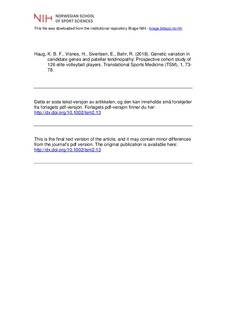Genetic variation in candidate genes and patellar tendinopathy: Prospective cohort study of 126 elite volleyball players
Journal article, Peer reviewed
Accepted version
Permanent lenke
http://hdl.handle.net/11250/2595893Utgivelsesdato
2018Metadata
Vis full innførselSamlinger
- Artikler / Articles [2096]
- Publikasjoner fra Cristin [1084]
Sammendrag
Variation in genes coding for structural proteins may represent risk factors for developing tendinopathy among athletes. The purpose of this prospective cohort study of elite volleyball students was to investigate whether specific single nucleotide variants (SNVs) in selected candidate genes, known to be associated with Achilles tendinopathy, were associated with the risk for developing patellar tendinopathy (jumper′s knee). Of 126 Caucasian athletes (64 females and 62 males), 33 cases (athletes developing jumper′s knee) were compared to 93 healthy controls. Six SNVs, distributed in the candidate genes COL1A1, COL5A1, MMP3, and GDF3, were genotyped. Baseline characteristics, genotypes, and minor allele frequencies (MAF) were compared between groups. Neither genotype nor minor allele frequencies differed significantly between the jumper′s knee group and the healthy controls. However, the low‐frequency homozygous T/T genotype of the COL1A1 gene (rs1800012) was absent in the jumper′s knee group (P = .075). Separating the two study groups by gender suggested that there may be a female‐specific genotype pattern, although the sample was too small for statistical calculations. In this study, although limited by sample size, we could not detect any clear relationship between six selected SNVs located in candidate genes and the risk for the development of jumper′s knee in elite volleyball students.
Beskrivelse
I Brage finner du siste tekst-versjon av artikkelen, og den kan inneholde ubetydelige forskjeller fra forlagets pdf-versjon. Forlagets pdf-versjon finner du på https://doi.org/10.1002/tsm2.13 / In Brage you'll find the final text version of the article, and it may contain insignificant differences from the journal's pdf version. The definitive version is available at https://doi.org/10.1002/tsm2.13
